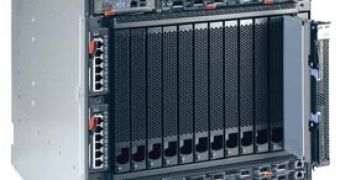The blade server design is one of the most popular and successful designs around the server market as it allows a greater degree of flexibility than other models and comes with several practical advantages like decreased price, ease of expandability and so on while maintaining a high performance.
In order to maintain is high status on the server market IBM announced the launch of a new generation of blade servers which are based on the Cell processor and feature an increased amount of memory while supporting a high data throughput, all of them critical pieces for high-end applications. Apart from the hardware upgrades, the new generation of IBM blade servers named BladeCenter QS21 are now smaller and the manufacturing company says that 14 such servers can be fitted into each server rack, compared to only seven when talking about the previous generation, the QS20. According to the news site computerworld which cites Paula Richards, product line manager for Cell systems at IBM, the new blade design can work in the most diverse environments being able to share the same workload with systems based on the x86 or the PowerPC hardware architecture.
"We're seeing many applications where users want to actually marry a quad-core Intel or AMD blade with a Cell blade, so they can use the standard blade for basic workloads, then push their mission-critical, exotic applications off to the Cell platform," the IBM Cell server manager said. IBM will begin selling the new Cell based blade servers in October to industrial users. Based on the Cell Broadband Engine processor which was created for Sony Computer Entertainment's PlayStation 3 gaming console by a joint venture between IBM, Sony and Toshiba, the BladeCenter QS21 is especially well suited for running visual tasks like 3-D rendering and time-critical jobs like compression and encryption. From the hardware point of view, each QS21 comes with two Cell processors running at 3.2GHz and a dual Gigabit Ethernet network connection and inside a computing cluster such a blade server can reach the mark of 6.4 TFLOPS in a BladeCenter H chassis, or 25.8 TFLOPS in a 42U rack. "We're not trying to be a general-purpose platform here. If you want to run your monthly statements or ERP, that's not what this is about," said Richards. "This is for time-critical, highly intense workloads like financial applications, digital video surveillance, medical imaging or even digital media and entertainment. Jobs where time is money."
This new Cell based blade server will supplement IBM's already existing line of blades which come running on several different hardware platforms like the IBM's own PowerPC chips or Intel's Xeon or Core 2 Duo chips and Advanced Micro Devices's Opteron processors. While the Xeon and Opteron based blade servers are well suited for general purpose jobs and while the PowerPC architecture is designed for a maximum performance inside an UNIX environment, the Cell based architecture is best used in image intensive applications signal processing and image analysis.

 14 DAY TRIAL //
14 DAY TRIAL //